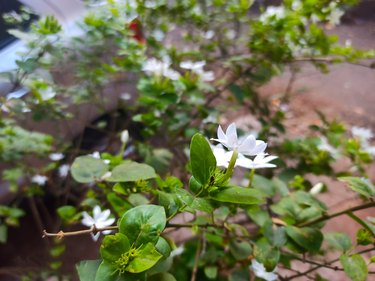
True jasmines (Jasminum spp.) are flowering shrubs or vines often cultivated for landscape use. Confederate jasmine (Trachelospermum jasminoides) is easily confused for a true jasmine species, but it is not related to other jasmines, such as winter jasmine (J. nudiflorum) and Asian star jasmine (T. asiaticum). Several parasitic insect groups in North America feed on jasmine leaves, stems and buds. Many of these pests cause mostly superficial damage, but some are serious enough to warrant destroying infested plants.
Caterpillars on Jasmine Leaves
Video of the Day
The larvae of several moth and butterfly species consume jasmine leaves until they reach maturity. The jasmine budworm (Hendecasis duplifascialis) drills holes in both leaves and flower buds, destroying the flower's petals before it blooms. The gallery worm (Elasmopalpus jasminophagus) and leaf web worm (Nausinoe geometralis) also damages jasmine foliage. According to TamilNadu Agricultural University, gallery worms create tunnels lined with a silky substance through their host's tissues. Leaf web worms create nests connected to multiple stems and consume large portions of their host's leaves.
Video of the Day
The best defense against caterpillars is to pick them off the plant's leaves by hand. Take a bucket of soapy water with you out to the yard. Patiently pick each caterpillar off the jasmine leaves individually. Many gardeners take a certain pleasure in squishing the pests. However, if you're squeamish you can simply drop the little beasties into the soapy water, where they'll drown.
Infestations of Tiny Mites
Several mite species infest jasmines and cause significant damage. Mites are extremely small and are difficult to see without a microscope or magnifying lens. These tiny organisms puncture the skin of leaves and stems and feed on their host's sap. The jasmine eriophyid mite (Aceria jasmini) and red spider mite (Tetranychus cinnabarinus) are both associated with leaf damage on jasmines. Uprooting and disposing of infected plants is often necessary to control an outbreak of these pests. Mite damage symptoms include discolored foliage and distorted growth. If you notice the jasmine plant's leaves curling, mealybugs are most likely the culprits.
Whiteflies Draining Leaf Sap
Whiteflies (Dialeurodes kirkaldyi) are common pests of citrus fruit trees in warmer parts of the United States. They are also a jasmine pest. They feed by draining sap from their host's leaves, causing them to turn yellow and shrivel. Adult whiteflies are barely more than 1 mm long and are even smaller during earlier development stages. This insect is found through Africa, North America, Australia and Asia. It preys on both Confederate jasmine and true jasmine species.
Masses of Mealybugs
Mealybugs are only a fraction of an inch long, but gather into clearly visible masses on the stems and leaves of jasmine and other host plants. They are not a serious pest, but can cause significant cosmetic damage that may lead put the plant's health at risk if not managed. They suck fluids from their host's tissues, causing leaves, flowers and new stems to wilt and die. According to the University of California, mealybugs secrete a substance called honeydew, which encourages the growth of an unsightly fungus called black sooty mold.